Urban Heat Island Simulations in Guangzhou, China, Using the Coupled WRF/UCM Model with a Land Use Map Extracted from Remote Sensing Data
Abstract
:1. Introduction
2. Data Sources and Methodology
2.1. Study Area
2.2. Model Configuration
2.3. Updated Land Use Data
2.4. Numerical Experiments
2.5. Observational Data
3. Simulation Analysis
3.1. Air Temperature at 2-m Height
3.2. Urban Heat Island Intensity (UHII)
3.3. Wind Velocity at 10-m Height
3.4. Energy Balance Data
4. Summary and Conclusions
- (1)
- Using the new land use data, the simulated 20 days of daily temperature cycles at the suburban weather station and four days of daily temperature cycles at urban point showed an encouraging agreement with observations, especially on hot sunny days. UCM_12 simulated maximum diurnal temperatures closer to the observed values than the simulations that excluded the UCM model. The coupled WRF/UCM with the new land use data improved the simulation performance.
- (2)
- Compared with the maximum UHII and the average local UHII, all of the simulated results reproduced the diurnal characteristics of UHI intensity. Both RS_12 and UCM_12 simulations performed better than the default geographic model, although they did not perfectly replicate the observations.
- (3)
- The modeled wind velocity results were higher than observations. The new land use data produced similar results as the default land use data. For the urban area, all wind velocity simulation results and observations were lower, and the UHII remains high during the nighttime.
- (4)
- The UCM_12 experiment successfully reproduced the differences in the energy equilibrium both in the urban and suburban areas. In the urban area, most of the input energy is used in sensible heating, which resulting the higher temperature, can be simulated by the WRF/UCM. The latent heat flux in the urban area is lower than in suburban area because lack of evapotranspiration of water vapor in the urban area. For the nocturnal situation, relatively high minimum temperature is reproduced in the urban owing to the sustained upward ground heat flux heats the atmosphere in the urban area.
Acknowledgments
Author Contributions
Conflicts of Interest
Abbreviations
| WRF | Weather Research and Forecasting |
| UCM | Urban Canopy Model |
| UHI | Urban Heat Island |
| CIT | Commercial/Industrial/Transportation |
| HIR | High-Intensity Residential |
| LIR | Low-Intensity Residential |
| UHII | Urban Heat Island Intensity |
References
- Foley, J.A.; DeFries, R.; Asner, G.P.; Barford, C.; Bonan, G.; Carpenter, S.R.; Chapin, F.S.; Coe, M.T.; Daily, G.C.; Gibbs, H.K.; et al. Global consequences of land use. Science 2005, 309, 570–574. [Google Scholar] [CrossRef] [PubMed]
- Cotton, W.R.; Pielke, R.A. Human Impacts on Weather and Climate; Cambridge University Press: Cambridge, UK, 2007. [Google Scholar]
- Zhang, C.L.; Chen, F.; Miao, S.G.; Li, Q.C.; Xia, X.A.; Xuan, C.Y. Impacts of urban expansion and future green planting on summer precipitation in the Beijing metropolitan area. J. Geophys. Res. Atmos. (1984–2012) 2009. [Google Scholar] [CrossRef]
- Kusaka, H.; Kondo, H.; Kikegawa, Y.; Kimura, F. A simple single-layer urban canopy model for atmospheric models: Comparison with multi-layer and slab models. Bound.-Layer Meteorol. 2001, 101, 329–358. [Google Scholar] [CrossRef]
- Chen, F.; Kusaka, H.; Bornstein, R.; Ching, J.; Grimmond, C.S.B.; Grossman-Clarke, S.; Loridan, T.; Manning, K.W.; Martilli, A.; Miao, S.; et al. The integrated WRF/urban modelling system: Development, evaluation, and applications to urban environmental problems. Int. J. Climatol. 2011, 31, 273–288. [Google Scholar] [CrossRef]
- Chen, F.; Kusaka, H.; Tewari, M.; Bao, J.W.; Hirakuchi, H. Utilizing the coupled WRF/LSM/Urban modeling system with detailed urban classification to simulate the urban heat island phenomena over the Greater Houston area. In Proceedings of the Fifth Symposium on the Urban Environment, Vancouver, BC, Canada, 23–27 August 2004.
- Yang, B.; Zhang, Y.; Qian, Y. Simulation of urban climate with high-resolution WRF model: A case study in Nanjing, China. Asia-Pac. J. Atmos. Sci. 2012, 48, 227–241. [Google Scholar] [CrossRef]
- Holt, T.; Pullen, J. Urban canopy modeling of the New York City metropolitan area: A comparison and validation of single-and multilayer parameterizations. Mon. Weather Rev. 2007, 135, 1906–1930. [Google Scholar] [CrossRef]
- Meng, W.; Zhang, Y.-X.; Li, J.-N.; Lin, W.-S.; Dai, G.-F.; Li, H.-H. Application of WRF/UCM in the simulation of a heat wave event and urban heat island around Guangzhou. J. Trop. Meteorol. 2011, 17, 256–265. [Google Scholar]
- Grossman-clarke, S.; Zehnder, J.A.; Loridan, T.; Grimmond, C.S.B. Contribution of land use changes to near-surface air temperatures during recent summer extreme heat events in the Phoenix metropolitan area. J. Appl. Meteorol. Climatol. 2010, 49, 1649–1664. [Google Scholar] [CrossRef]
- Jiang, X.; Wiedinmyer, C.; Chen, F.; Yang, Z.-L.; Lo, J.C.-F. Predicted impacts of climate and land use change on surface ozone in the Houston, Texas, area. J. Geophys. Res. Atmos. (1984–2012) 2008. [Google Scholar] [CrossRef]
- Chen, J.; Li, Q.; Niu, J.; Sun, L. Regional climate change and local urbanization effects on weather variables in Southeast China. Stochast. Environ. Res. Risk Assess. 2011, 25, 555–565. [Google Scholar] [CrossRef]
- Xiao, D.; Chen, J.; Chen, Z.; Zhang, B. Effect Simulation of Chengdu Fine Underlying Surface Information on Urban Meteorology. Meteorol. Mon. 2011, 37, 298–308. [Google Scholar]
- Kuang, W.; Liu, J.; Zhang, Z.; Lu, D.; Xiang, B. Spatiotemporal dynamics of impervious surface areas across China during the early 21st century. Chin. Sci. Bull. 2013, 58, 1691–1701. [Google Scholar] [CrossRef]
- Miao, S.; Chen, F.; Lemone, M.A.; Tewari, M.; Li, Q.; Wang, Y. An Observational and Modeling Study of Characteristics of Urban Heat Island and Boundary Layer Structures in Beijing. J. Appl. Meteorol. Climatol. 2009. [Google Scholar] [CrossRef]
- Lin, C.-Y.; Chen, W.-C.; Chang, P.-L.; Sheng, Y.-F. Impact of the urban heat island effect on precipitation over a complex geographic environment in Northern Taiwan. J. Appl. Meteorol. Climatol. 2011, 50, 339–353. [Google Scholar] [CrossRef]
- Cheng, F.-Y.; Hsu, Y.-C.; Lin, P.-L.; Lin, T.H. Investigation of the effects of different land use and land cover patterns on mesoscale meteorological simulations in the Taiwan area. J. Appl. Meteorol. Climatol. 2013, 52, 570–587. [Google Scholar] [CrossRef]
- Li, Y.; Okaze, T.; Mochida, A. Prediction of the impacts of urbanization using a new assessment system combining an urban expansion model and WRF-Case study for Guangzhou in China. J. Heat Island Inst. Int. 2014, 9, 133–137. [Google Scholar]
- Chen, F.; Yang, X.; Zhu, W. WRF simulations of urban heat island under hot-weather synoptic conditions: The case study of Hangzhou City, China. Atmos. Res. 2014, 138, 364–377. [Google Scholar] [CrossRef]
- Li, Y.; Song, Y.H.; Mochida, A.; Okaze, T. WRF Environment Assessment in Guangzhou City with an Extracted Land-use Map from the Remote Sensing Data in 2000 as an Example. J. Harbin Inst. Technol. 2014, 21, 26–32. [Google Scholar]
- Cheng, C.K.M.; Chan, J.C.L. Impacts of land use changes and synoptic forcing on the seasonal climate over the Pearl River Delta of China. Atmos. Res. 2012, 60, 25–36. [Google Scholar] [CrossRef]
- Kusaka, H.; Kimura, F. Thermal effects of urban canyon structure on the nocturnal heat island: Numerical experiment using a mesoscale model coupled with an urban canopy model. J. Appl. Meteorol. 2004, 43, 1899–1910. [Google Scholar] [CrossRef]
- AL-Ahmadi, F.S.; Hames, A.S. Comparison of Four Classification Methods to Extract Land Use and Land Cover from Raw Satellite Images for Some Remote Arid Areas, Kingdom of Saudi Arabia. King Abdul. Univ. 2009, 20, 167–191. [Google Scholar] [CrossRef]
- Lu, D.; Tian, H.; Zhou, G.; Ge, H. Regional mapping of human settlements in southeastern China with multisensor remotely sensed data. Remote Sens. Environ. 2008, 112, 3668–3679. [Google Scholar] [CrossRef]
- Elvidge, C.D.; Baugh, K.E.; Kihn, E.A.; Kroehl, H.W.; Davis, E.R. Mapping city lights with nighttime data from the DMSP Operational Linescan System. Photogramm. Eng. Remote Sens. 1997, 63, 727–734. [Google Scholar]
- Elvidge, C.D.; Baugh, K.E.; Dietz, J.B.; Bland, T.; Sutton, P.C.; Kroehl, H.W. Radiance Calibration of DMSP-OLS Low-Light Imaging Data of Human Settlements. Remote Sens. Environ. 1999, 68, 77–88. [Google Scholar] [CrossRef]
- Maisongrande, P.; Duchemin, B.; Dedieu, G. VEGETATION/SPOT: An operational mission for the Earth monitoring; presentation of new standard products. Int. J. Remote Sens. 2004, 25, 9–14. [Google Scholar] [CrossRef]
- Willmott, C.J. Some comments on the evaluation of model performance. Bull. Am. Meteorol. Soc. 1982, 63, 1309–1313. [Google Scholar] [CrossRef]
- Srunnaa, M.; Sethuraman, S. A statistical evaluation and comparison of coast point source dispersion models. Atmos. Environ. 1986, 20, 301–315. [Google Scholar]
- Oke, T.R. The energetic basis of the urban heat island. Quart. J. Royal Meteorol. Soc. 1982, 108, 1–24. [Google Scholar] [CrossRef]
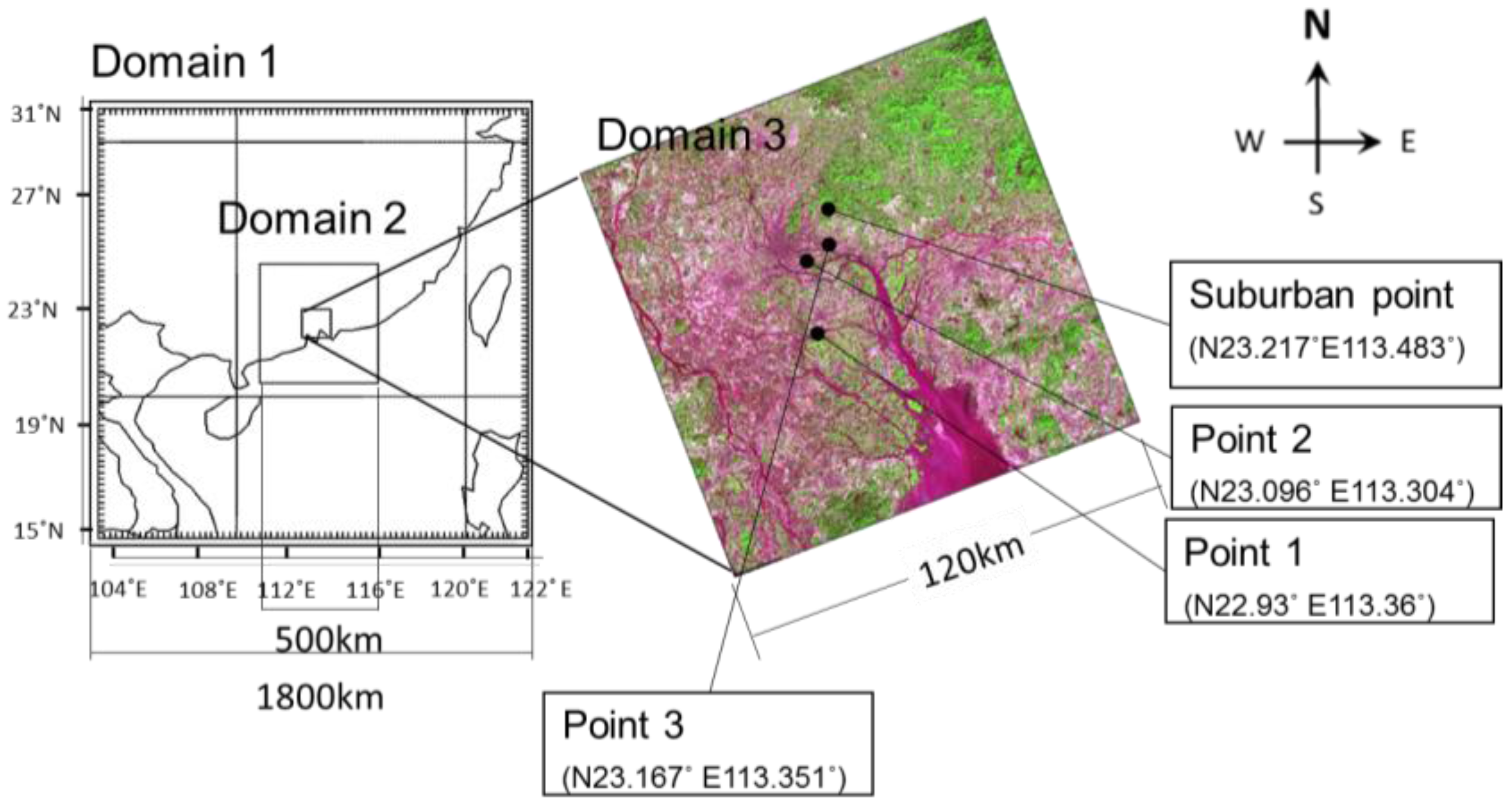

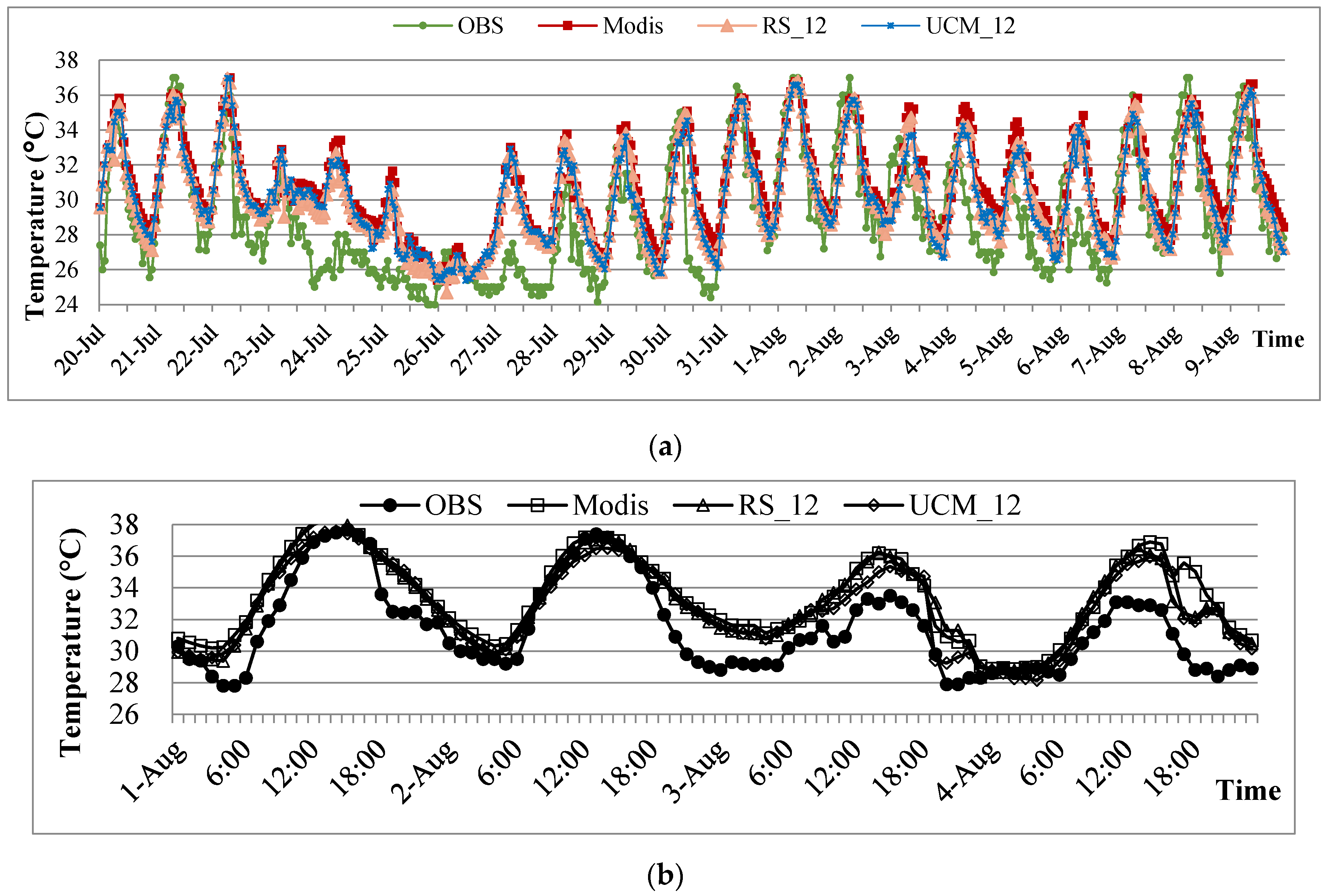





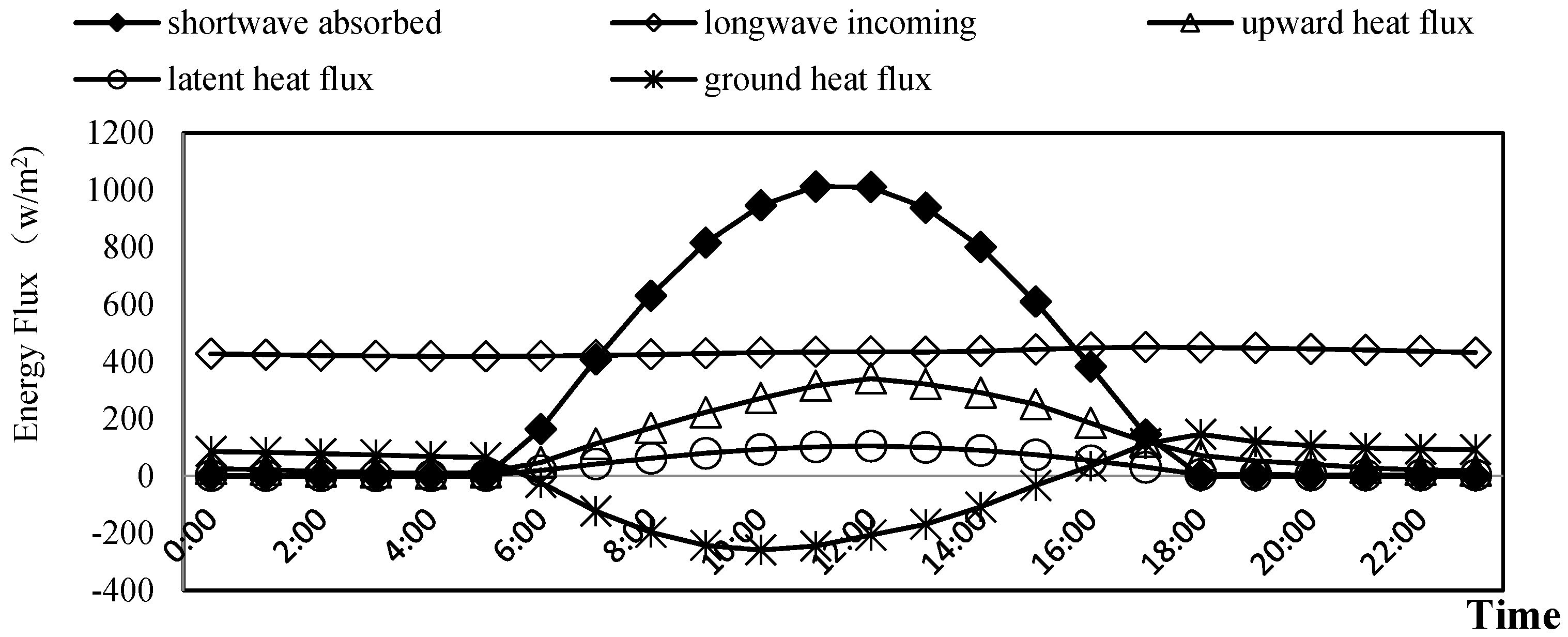
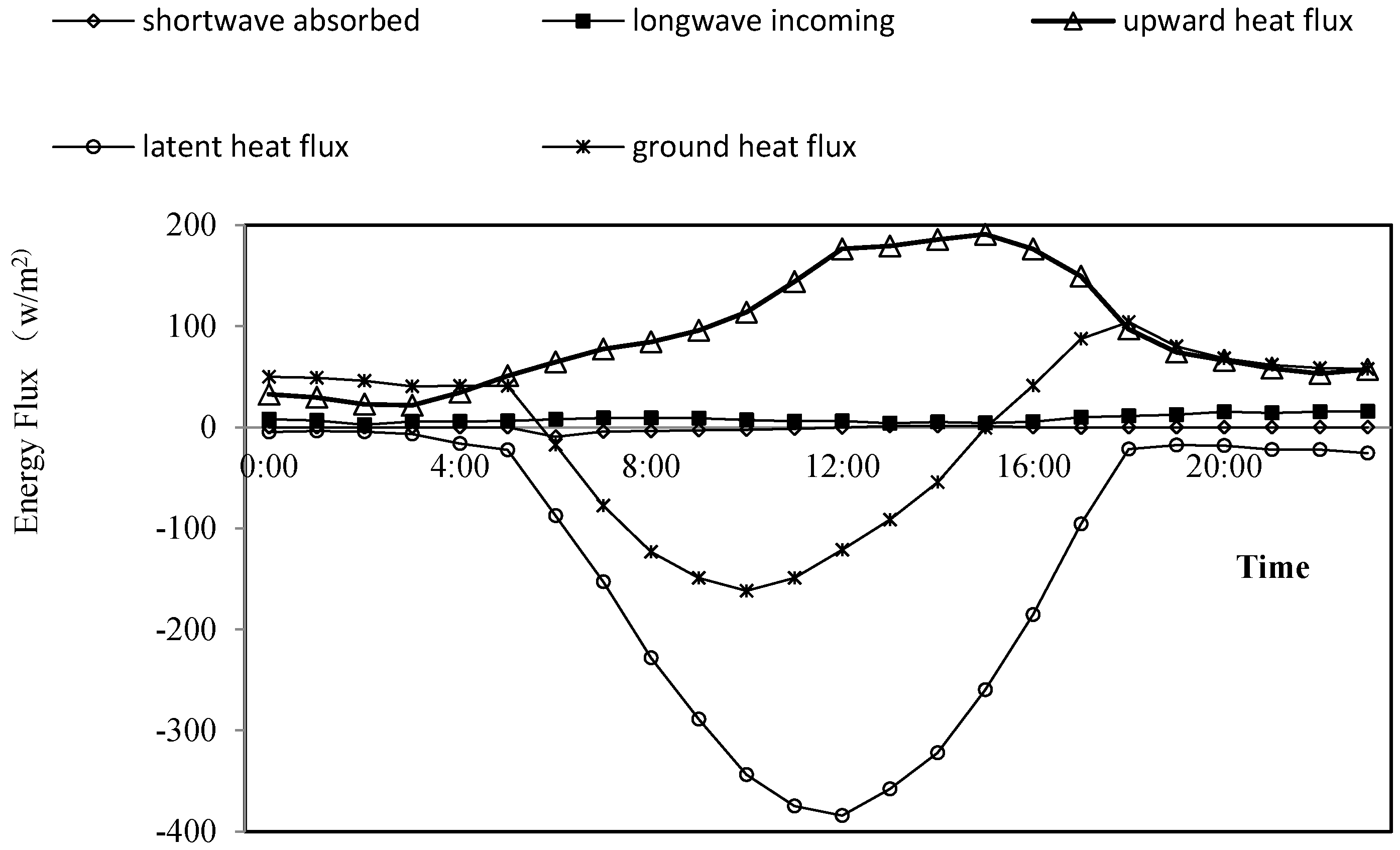
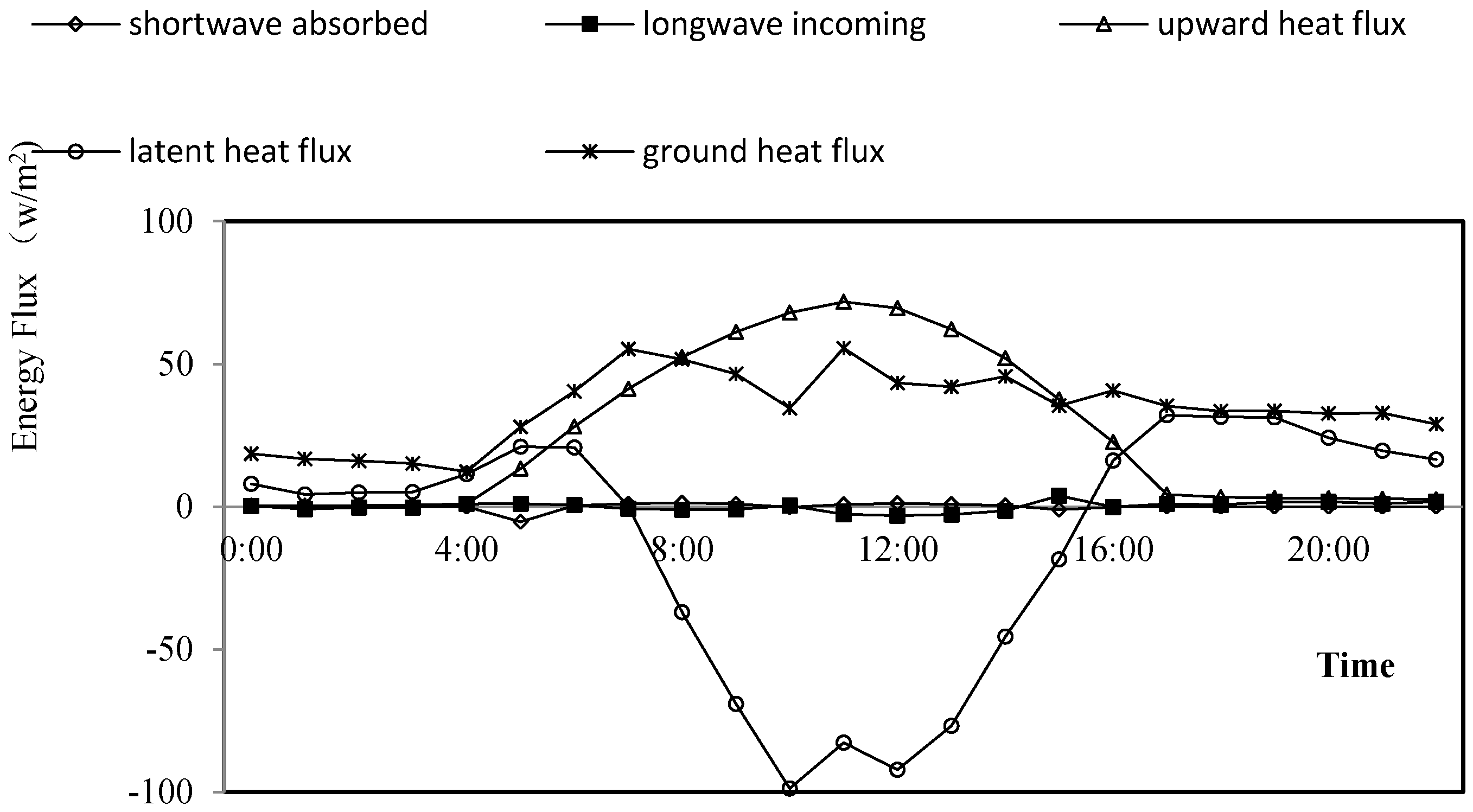
| Simulation Time | 20 July 2012 00:00–20 August 2012 00:00 (GMT) |
|---|---|
| Meteorological data | National Centers for Environmental Prediction Final Operational Global Analysis data |
| Long-wave radiation | Rapid radiative transfer model (RRTM) long-wave radiation scheme |
| Short-wave radiation | Dudhia short-wave radiation scheme |
| Surface layer | Monin–Obukhov scheme |
| Land surface | Noah land-surface model+ single-layer Urban Canopy Model (UCM) |
| Cumulus | Kain–Fritsch (new Eta) scheme |
| Short-wave radiation | Dudhia scheme |
| Micro-physics | WRF Double-Moment 6-class |
| Boundary layer | Yonsei University (YSU) boundary layer scheme |
| Experiments | UCM | Land Use |
|---|---|---|
| Modis | No | MODIS |
| RS_12 | No | Extracted from Landsat-7 RS data |
| UCM_12 | Yes | Enhancement of the extracted land use data from Landsat-7 by HSI |
| Suburban | Urban * | |||||||
|---|---|---|---|---|---|---|---|---|
| OBS | MODIS | RS_12 | UCM_12 | OBS | MODIS | RS_12 | UCM_12 | |
| T2M (°C) | 30.4 | 31.8 | 31.3 | 31.2 | 32.8 | 34.3 | 33.6 | 33.4 |
| T2MAX (°C) | 37.0 | 36.8 | 36.8 | 36.6 | 37.5 | 38.1 | 37.8 | 37.3 |
| T2MIN (°C) | 26.6 | 27.9 | 27.1 | 26.7 | 28.0 | 30.2 | 29.0 | 28.9 |
| Comparison Points | MODIS | |||
| d | RMSEs | RMSEu | RMSE | |
| Suburban point | 0.79 | 1.48 | 1.88 | 2.40 |
| Point 1 | 0.82 | 2.00 | 1.42 | 2.45 |
| Point 2 | 0.88 | 0.60 | 1.47 | 1.59 |
| Point 3 | 0.74 | 2.37 | 1.60 | 2.86 |
| RS_12 | ||||
| d | RMSEs | RMSEu | RMSE | |
| Suburban point | 0.86 | 1.03 | 1.72 | 2.00 |
| Point 1 | 0.86 | 1.70 | 1.33 | 2.15 |
| Point 2 | 0.90 | 0.34 | 1.37 | 1.41 |
| Point 3 | 0.94 | 2.26 | 1.45 | 2.69 |
| UCM_12 | ||||
| d | RMSEs | RMSEu | RMSE | |
| Suburban point | 0.89 | 1.03 | 1.73 | 2.01 |
| Point 1 | 0.90 | 1.46 | 1.38 | 2.02 |
| Point 2 | 0.93 | 0.29 | 1.51 | 1.53 |
| Point 3 | 0.95 | 2.10 | 1.69 | 2.69 |
| Comparison Points | MODIS | |||
| d | RMSEs | RMSEu | RMSE | |
| Suburban point | 0.64 | 1.59 | 1.31 | 2.06 |
| Point 1 | 0.51 | 1.54 | 0.78 | 1.73 |
| Point 2 | 0.44 | 1.42 | 0.74 | 1.61 |
| Point 3 | 0.43 | 1.59 | 0.82 | 1.79 |
| RS_12 | ||||
| d | RMSEs | RMSEu | RMSE | |
| Suburban point | 0.68 | 1.03 | 1.72 | 2.00 |
| Point 1 | 0.49 | 1.65 | 0.77 | 1.82 |
| Point 2 | 0.34 | 2.10 | 0.85 | 2.27 |
| Point 3 | 0.53 | 1.24 | 1.45 | 2.69 |
| UCM_12 | ||||
| d | RMSEs | RMSEu | RMSE | |
| Suburban point | 0.70 | 1.01 | 1.01 | 1.47 |
| Point 1 | 0.52 | 1.55 | 0.64 | 1.68 |
| Point 2 | 0.45 | 1.42 | 0.74 | 1.61 |
| Point 3 | 0.50 | 1.35 | 0.80 | 1.57 |
© 2016 by the authors; licensee MDPI, Basel, Switzerland. This article is an open access article distributed under the terms and conditions of the Creative Commons Attribution (CC-BY) license (http://creativecommons.org/licenses/by/4.0/).
Share and Cite
Chen, G.; Zhao, L.; Mochida, A. Urban Heat Island Simulations in Guangzhou, China, Using the Coupled WRF/UCM Model with a Land Use Map Extracted from Remote Sensing Data. Sustainability 2016, 8, 628. https://doi.org/10.3390/su8070628
Chen G, Zhao L, Mochida A. Urban Heat Island Simulations in Guangzhou, China, Using the Coupled WRF/UCM Model with a Land Use Map Extracted from Remote Sensing Data. Sustainability. 2016; 8(7):628. https://doi.org/10.3390/su8070628
Chicago/Turabian StyleChen, Guang, Lihua Zhao, and Akashi Mochida. 2016. "Urban Heat Island Simulations in Guangzhou, China, Using the Coupled WRF/UCM Model with a Land Use Map Extracted from Remote Sensing Data" Sustainability 8, no. 7: 628. https://doi.org/10.3390/su8070628
APA StyleChen, G., Zhao, L., & Mochida, A. (2016). Urban Heat Island Simulations in Guangzhou, China, Using the Coupled WRF/UCM Model with a Land Use Map Extracted from Remote Sensing Data. Sustainability, 8(7), 628. https://doi.org/10.3390/su8070628






